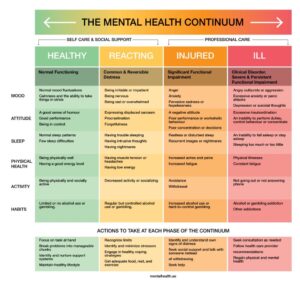Talk of mental health awareness is everywhere these days…and for good reason. First, the unparalleled global and economic craziness we are experiencing has people experiencing massive mental health swings, sometimes on a daily basis.
Depression, anxiety, pessimism, and panic seem to be everywhere. Then again so are teamwork, collaboration, community engagement, positivity, and proactive action. If you choose to tune your brain into looking for it.
Second, mainstream societal awareness and acceptance of mental health have been rising quickly over the past few years. Our current circumstances have thrust it firmly into the limelight.
People who formerly dismissed mental health awareness as “fake news”, a sign of weakness or something used by those who were lazy and didn’t want to work are starting to realize…” Hmmm, maybe there is something to this whole ‘mental health’ thing”.
The fact is, despite large strides in research, awareness, and acceptance, ignorance and misinformation are still rampant surrounding mental health.
At the heart of this is the fact that many people still think mental health is a nicer way of talking about mental illness. Because there is a stigma around being seen as mentally ill.
While I will provide a quick distinction between the two, mental illness isn’t the focus today. I want to focus on mental health awareness and how understanding it can directly benefit our lives and the lives of those around us.
In case it wasn’t yet clear…let me clarify: Mental health and mental illness are NOT the same things.
According to the Oxford Dictionary, mental health is a noun that means:
“A person’s condition with regard to their psychological and emotional well-being.” A sample sentence is: “All this pressure and uncertainty around COVID-19 and working from home seems to be affecting his mental health”.
The World Health Organization (WHO) is a bit more specific:
“Mental health is a state of well-being in which the individual realizes his or her own abilities, can cope with the normal stresses of life, can work productively and fruitfully, and is able to make a contribution to his or her community”
They then go on to say that mental health includes “subjective well-being, perceived self-efficacy, autonomy, competence, inter-generational dependence, and self-actualization of one’s intellectual and emotional potential, among others”.
Think of it this way. Everyone has health, but not everyone has an illness. The mental side is the same. Everyone has mental health, but not everyone will have a mental illness.

In fact, there is no health without mental health.
It’s part of the whole package. Overall health consists of many areas. Depending on which list you look at, anywhere from 5 to 12 components will be listed. However, they all include Mental/Intellectual, Physical, Emotional, Social, and Environmental.
Expanded lists include things like: financial, community/family, spiritual, and others. Regardless of how much you expand the list, it’s clear that our health/wellness/well-being is a combination of many areas and is constantly in flux.
Throughout our lives, we will have many “ups and downs” in our mental health. Our moods, thoughts, and feelings will fluctuate, and our actions in these situations will change.
THIS IS NORMAL!
We all experience these fluctuations. There is nothing wrong with feeling down at times, or super, or somewhere in the middle.
These emotions and feelings should correspond closely to what we are experiencing, and how we are managing the other areas of our lives.
A strong overall health framework (including mental health) makes us RESILIENT and provides us a greater capacity to cope with and manage stressors, challenges, and changes in our life.
It’s also important to note that like our physical health, failing to properly care for our mental health can lead to mental illness. In fact, mental and physical health are intimately linked (something that many people, even in the fitness industry overlook).
The power of moving our body properly and strategically each day is an incredible tool in our mental health toolbox.
The great news is that it also improves our physical health! Notice how I didn’t say exercise? Movement is foundational and different than activity, exercise, fitness, and performance.
These pieces together (in that order) are what we call the Movement Spectrum and understanding how they interact in our life is a valuable tool for effectively managing your health.
Diving into that is a different post, but it’s important to know. For more detail, check out Chapter 3.1 (pg. 155) in my book, The Fitness Curveball.

Let’s get back to mental health, and how to recognize our changes, and effectively manage them over time.
There are a number of different frameworks out there, but my favorite is the Mental Health Continuum Model. Almost every country has its own version, but they all contain essentially the same spectrum and actions seen below.
The mental health continuums are generally modified from the work of Dr. John Travis back in the 1960s. He was one of the first mainstream physicians to posit that wellness was not simply the absence of Illness. He posited that there were many levels of both wellness and illness. You can see a modification of his original illness-wellness continuum below.

Since mental health is one component of overall health, I felt it best to show you the similarities in the continuum.
The following mental health continuum image is actually from an independent website (mentalhealth.ae) in UAE that has taken the traditional continuum model and segmented it into easy-to-navigate components (habits, sleep, attitude, etc.).

This Mental Health Continuum Model is a great way to check in with yourself and those around you to see how you (and they) are doing. Using this model you are able to quickly identify where you may be sitting on the spectrum and what to do to improve your current situation. In case you were wondering…YES…it’s NORMAL to fluctuate on a regular basis.
Seeing the various segments on the left axis is also a great way to draw attention to particular areas you may need more help with…and that is working particularly well to help you cope.
When you notice yourself getting into the yellow or orange areas, it’s possible to seek help and take action to move you to the left on the spectrum, and avoid slipping further towards the red area and illness. Keep in mind that periodically, you may find yourself in the red. Being aware of this spectrum will allow you to identify it earlier and seek help sooner.
Additionally, ensuring that you are aware of the continuum and positive actions in each area can help you identify those around you who may need support and help in various ways.
As a friend, family member, leader, and all-around awesome person, I encourage you to familiarize yourself with this continuum and take courses for leaders and workplaces such as The Working Mind from the Mental Health Commission of Canada.
The interesting thing to note is that the actions and recommendations for mental health are very similar to many of the 4 Pillars of coaching strategies (Mindset, Habits, Movement, Fuel) that we use for igniting potential and performance in our executive and corporate coaching clients.
Here’s a short summary of the various actions that will improve your mental (and physical…and overall) health.
- Get a great sleep
- Create a strong social support circle (family, friends, community)
- Improve your personal “administration” (Set goals, plan, schedule, prioritize, take action)
- Move your body multiple times per day.
- Move vigorously enough to work up a sweat at least a few times per week.
- Find physical activities you love to do…ideally with your social support circle
- Cultivate hobbies that challenge your mind (music, language, volunteering, etc.)
- Build a positive, proactive, growth-oriented mindset about life (studies show that “lucky” people create their own luck)!
- Seek out opportunities to compliment, help, and encourage others each day…even if you do it for the selfish reason that you will feel better because of it. 🙂
The great news is that you are in control of each of these areas.
YOU have the power and ability to improve your mental health. Doing this will supercharge your health, happiness, performance, and fulfillment in life. Regardless of your goals, achieving them will be easier when you are healthier, happier, and more aware of the control you have over your outcomes in life.
Many people intuitively understand this, but still have trouble getting the right things done at the right time (I’ve been there…and like everyone, still am in some areas of life).
If this sounds like you and you want some help moving past these barriers, just book your FREE Success Coaching Session with FRESH! team, and let us help you.
In the meantime, determine where you currently are on the illness-wellness and mental health continuums. They are very helpful!



